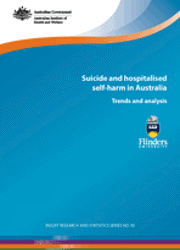Suicide and hospitalised self-harm in Australia: trends and analysis
Citation
AIHW
Australian Institute of Health and Welfare (2014) Suicide and hospitalised self-harm in Australia: trends and analysis, AIHW, Australian Government, accessed 26 April 2024.
APA
Australian Institute of Health and Welfare. (2014). Suicide and hospitalised self-harm in Australia: trends and analysis. Canberra: AIHW.
MLA
Australian Institute of Health and Welfare. Suicide and hospitalised self-harm in Australia: trends and analysis. AIHW, 2014.
Vancouver
Australian Institute of Health and Welfare. Suicide and hospitalised self-harm in Australia: trends and analysis. Canberra: AIHW; 2014.
Harvard
Australian Institute of Health and Welfare 2014, Suicide and hospitalised self-harm in Australia: trends and analysis, AIHW, Canberra.
PDF | 3.9Mb
This report describes suicide and hospitalised self-harm in Australia. Suicide occurring in 2010–11 is described statistically, and trends are shown for the period from the early 1920s. Patterns of suicide over time were also examined for selected birth cohorts. Hospitalised intentional self-harm in 2010–11 is also described, and trends are examined for the period from 1999–00. Both suicide and hospitalised intentional self-harm are analysed by mechanism of injury, sex, age group, Indigenous status and other factors.
- ISSN: 1444-3791
- ISBN: 978-1-74249-669-6
- Cat. no: INJCAT 169
- Pages: 155
-
For males born in the 20th century, suicide rates from about 50 years have been lower in each more recent generation
-
Suicide rates tended to increase with the remoteness of the person's place of residence
-
Female cases of intentional self-harm out-numbered male cases most markedly in the teen years
-
Poisons (except gas) accounted for almost 82% of all hospitalisations due to intentional self- harm



